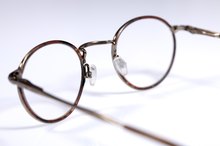What does fact checked mean?
At Healthfully, we strive to deliver objective content that is accurate and up-to-date. Our team periodically reviews articles in order to ensure content quality. The sources cited below consist of evidence from peer-reviewed journals, prominent medical organizations, academic associations, and government data.
The information contained on this site is for informational purposes only, and should not be used as a substitute for the advice of a professional health care provider. Please check with the appropriate physician regarding health questions and concerns. Although we strive to deliver accurate and up-to-date information, no guarantee to that effect is made.
Convergence Insufficiency Exercises for Children
Convergence insufficiency occurs when a child is unable to keep both eyes working together at a near distance 2. Children with convergence insufficiency usually have one eye turn outward while trying to focus on a word or object closer than a certain distance 2. Convergence insufficiency symptoms include double vision, headaches when reading, squinting, problems concentrating on near work and blurred vision during longer periods of reading or when tired 2. Children suspected of having convergence insufficiency should be examined by an eye doctor to assess if further treatment is necessary 2. Practicing convergence through exercises can often treat convergence insufficiency, says the American Association for Pediatric Ophthalmology and Strabismus 2.
String Exercise
This exercise requires a 15 foot-long piece of string and three buttons. Tie the string to a doorknob and bead the three buttons onto it so that they lie 6 inches, 18 inches and 4 feet from the untied end of the string. Have the child hold the end of the string up tight against the tip of her nose and look at the closest buttonhole. If the child’s eyes are working together correctly, she should see two strings crossing right at the opening of the first button. When the child sees the strings crossing at the buttonhole, she should keep her eyes focused there for 10 counts. She should then complete the same process for the next two buttons, repeating the entire cycle five times.
- This exercise requires a 15 foot-long piece of string and three buttons.
- When the child sees the strings crossing at the buttonhole, she should keep her eyes focused there for 10 counts.
Pencil Push-Ups
Eye Exercises for Esotropia
Learn More
Have the child focus on one of the small letters on the side of a pencil while moving it closer to her nose. She should stop advancing the pencil once she starts to experience double vision. Pencil push-ups should be done for 15 minutes daily, at least five days a week. During one session, she should expect to repeat the exercise at least 100 times. AdvanceMed Hanford Occupational Health Services suggests adding an additional step: Have her imagine there is a tic-tac-toe board in front of her, then bring the pencil in from each box using only her eyes.
- Have the child focus on one of the small letters on the side of a pencil while moving it closer to her nose.
- AdvanceMed Hanford Occupational Health Services suggests adding an additional step: Have her imagine there is a tic-tac-toe board in front of her, then bring the pencil in from each box using only her eyes.
Focal Flexibility Exercise
Have the child hold her index finger close to the tip of her nose and fix her gaze on her fingertip. Next, while continuing to look at her fingertip, have her move her hand away until her arm is fully extended, then bring it back in to her nose. Repeat this exercise 20 times. This exercise can be helpful by improving the flexibility of the eye’s crystalline lenses. The eyes must shift their focus from near to far easily in order for vision to be clear. An inflexible crystalline lens can lead to eye strain and affect the eyes' ability to focus.
- Have the child hold her index finger close to the tip of her nose and fix her gaze on her fingertip.
- An inflexible crystalline lens can lead to eye strain and affect the eyes' ability to focus.
Related Articles
References
- MayoClinic.com: Convergence Insufficiency
- Eye-Exercises-For-Good-Vision.com: Focal Flexibility Exercise
- Barnhardt C, Cotter SA, Mitchell GL, Scheiman M, Kulp MT. Symptoms in children with convergence insufficiency: before and after treatment. Optom Vis Sci. 2012;89(10):1512-20. doi:10.1097/OPX.0b013e318269c8f9
- Convergence Insufficiency. Scheiman Vision Therapy [internet].
- Yaramothu C, Santos EM, Alvarez TL. Effects of visual distractors on vergence eye movements. J Vis. 2018;18(6):2. doi:10.1167/18.6.2
- Hassan LI, Ibrahim SM, Abdu M, Mohamedsharif A. Prevalence of convergence insufficiency among secondary school students in Khartoum, Sudan. Oman J Ophthalmol. 2018;11(2):129-133. doi:10.4103/ojo.OJO_170_2017
- Ostrow GI, Del Monte MA, Al-Hashimi MR. Convergence Insufficiency. American Academy of Ophthalmology, Eye Wiki [internet]. Updated 15 Nov 2019.
- Przekoracka-krawczyk A, Michalak KP, Pyżalska P. Deficient vergence prism adaptation in subjects with decompensated heterophoria. PLoS ONE. 2019;14(1):e0211039. doi:10.1371/journal.pone.0211039
- Convergence Insufficiency. American Association for Pediatric Ophthalmology and Strabismus [internet]. Updated 26 Feb 2019.
- Momeni-moghaddam H, Kundart J, Azimi A, Hassanyani F. The effectiveness of home-based pencil push-up therapy versus office-based therapy for the treatment of symptomatic convergence insufficiency in young adults. Middle East Afr J Ophthalmol. 2015;22(1):97-102. doi:10.4103/0974-9233.148357
- Scheiman M, Mitchell GL, Cotter SA, et al. Convergence Insufficiency Treatment Trial - Attention and Reading Trial (CITT-ART): Design and Methods. Vis Dev Rehabil. 2015;1(3):214-228.
- Part 2: treatment of Convergence Insufficiency. Fulton Eyecare Center [internet].
- Convergence Insufficiency Treatment Trial Study Group. Randomized clinical trial of treatments for symptomatic convergence insufficiency in children. Arch Ophthalmol, Oct 2008.
Resources
Writer Bio
Kimberley Zagoren has been writing since 2002. With experience in pediatric and neonatal intensive care nursing, Zagoren writes for several online sources, such as eHow, focusing primarily on health-related issues. She received her Associate of Science in nursing degree from Middlesex College.









